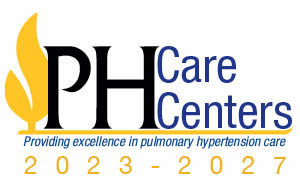
Schedule an appointment with the GW Pulmonary Hypertension Team
To schedule an appointment, call 202-795-2792 or send an email to PHTNatmfa@mfa.gwu.edu.
Pulmonary (lung) hypertension (PH) is a type of high blood pressure that affects the tubes that carry oxygen (arteries) in your lungs and weakens the right side of your heart. Eventually the heart fails to work properly (heart failure).
The team at the GW Pulmonary Hypertension Program provides advanced treatments for this uncommon, but potentially fatal condition. Our doctors provide the most advanced care available, based on more than 20 years of experience with PH.
The team includes internationally recognized cardiologists who are experts in PH, pulmonologist and rheumatologists who are experts in associated pulmonary vascular disease and its associated PH conditions, as well as specially trained nurses who provide assistance and support to families. Our inpatient cardiovascular nurses are all trained in the acute care of these patients. We take a multidisciplinary comprehensive approach to treatment, with expertise not only in PH but also multi-modality cardiac imaging and cardiac prevention, and heart rhythm diagnoses and treatments.
Watch this video as Dr. Mardi Gomberg, Director of the GW Pulmonary Hypertension Program, discusses how pulmonary hypertension is diagnosed and treated.
Accredited as a Pulmonary Hypertension Center of Comprehensive Care Program
The GW site is the first accredited Comprehensive Care Center in Washington, DC
 GW Hospital, in conjunction with the MFA Division of Cardiology and the George Washington School of Medicine and Health Sciences, received accreditation as a Pulmonary Hypertension Center of Comprehensive Care (CCC) Program in August 2023. This prestigious designation is awarded by the Pulmonary Hypertension Association (PHA) to nationally recognized programs that excel in clinical care and clinical research for patients with this rare disease. Over the last 25 years there have been significant gains in knowledge about the disease, but little on the differences in race and ethnically diverse patient populations like in Washington DC.
GW Hospital, in conjunction with the MFA Division of Cardiology and the George Washington School of Medicine and Health Sciences, received accreditation as a Pulmonary Hypertension Center of Comprehensive Care (CCC) Program in August 2023. This prestigious designation is awarded by the Pulmonary Hypertension Association (PHA) to nationally recognized programs that excel in clinical care and clinical research for patients with this rare disease. Over the last 25 years there have been significant gains in knowledge about the disease, but little on the differences in race and ethnically diverse patient populations like in Washington DC.
Meet the Pulmonary Hypertension Program Director
 Mardi Gomberg, MD, Professor of Medicine and Director of the GW Pulmonary Hypertension Program
Mardi Gomberg, MD, Professor of Medicine and Director of the GW Pulmonary Hypertension Program
Dr. Mardi Gomberg is an internationally recognized leader in the field of pulmonary hypertension. She has participated in over 50 clinical trials and has over 165 publications and 10 book chapters.
Symptoms of Pulmonary Hypertension
The signs and symptoms of PH in its early stages might not be noticeable for months or even years. As the disease progresses, symptoms become worse. Oftentimes when patients are first diagnosed, their symptoms are severe.
Symptoms of PH include:
- Shortness of breath (dyspnea), initially while exercising and eventually while at rest
- Fatigue
- Dizziness or fainting spells (syncope)
- Chest pressure or pain
- Swelling (edema) in the ankles, legs and eventually in the abdomen (ascites)
- Bluish color to lips and skin (cyanosis)
- Racing pulse or heart palpitations
Classifications of Pulmonary Hypertension
PH is classified into five groups, depending on the cause:
- Group 1: Pulmonary arterial hypertension (PAH), cause unknown, known as idiopathic pulmonary arterial hypertension and associated causes (i.e. connective tissue disease, congenital heart disease, liver disease, HIV)
- Group 2: PH caused by left-sided heart disease
- Group 3: PH caused by lung disease
- Group 4: PH caused by chronic blood clots (blood blockages)
- Group 5: PH associated with other conditions that have unclear reasons why the pulmonary hypertension occurs
Diagnosis
Your doctor may suspect that you have PH based on noninvasive tests, such as an electrocardiogram or echocardiogram. Because an accurate diagnosis is critical to your care, you may need additional tests to rule out other possible heart problems. Our team recommends several tests, including a cardiac catheterization. This enables doctors to diagnose PH and determine the best treatment plan, tailored specifically for each patient.
Other tests available to help detect PH include:
- Blood tests that help determine the cause of the disease and track the disease and its response to treatments
- Testing oxygen levels at rest and while walking
- Exercise tests to determine your ability and endurance
- Magnetic resonance imaging (MRI), which can be valuable in checking for any unusual heart conditions and carefully evaluating the right side of the heart
- Perfusion lung scans, to check for blood clots that may contribute to PH
- Pulmonary function tests, which measure airflow in and out of your lungs
- Sleeping tests to determine your ability to breathe and level of oxygen
- Computed tomography (CT) pictures of the lung and pulmonary angiograms, pictures of lung blood vessels (tubes)
Treatments
Treatment options are dependent on the cause of your PH. Our doctors have led the development of new medications and have done research on the difference in patients who get the disease. Although the treatment plans are often complex and are given out by specialty drug suppliers, our doctors and nurses have experience using these potentially lifesaving therapies and monitoring patients' progress during follow-up.
Treatment for Group 1 PAH
This includes a variety of oral and inhaled medicines, as well as an IV pump that delivers medication directly into the bloodstream. Some of these treatments include diuretics, anticoagulants (blood thinners), digoxin and oxygen.
If medications don't control your pulmonary hypertension, then an interventional procedure in the catheterization lab might be an option. In an atrial septostomy, an interventional cardiologist will create an opening between the upper left and right chambers of your heart (atria) to relieve the pressure on the right side of your heart.
In some cases, a lung or heart-lung transplant might be an option, especially for younger people who have idiopathic pulmonary arterial hypertension.
Treatment for Group 2 PH
The focus for treating PH caused by left-sided heart disease is treating the failing heart and its symptoms. A treatment that reverses the high pressure in the lungs is in clinical development.
Treatment for Group 3 PH
Treatments for PH from lung disease are dependent on the cause of the lung disease. Research is ongoing with drugs to lower the pressure.
Treatment for Group 4 PH
Treatments for PH caused by chronic blood clots include medications, oxygen, riociguat, and procedures to open the tubes and clear the clot (balloon opening, or angioplasty). In some patients, surgery is required to clear the blockages. Surgery can restore normal heart and lung function.
Treatment for Group 5 PH
Sarcoidosis, a disorder that affects multiple organs in the body, but mostly the lungs, can be treated. Clinical research is ongoing with different approved therapies for high pressure in the blood vessels (PAH).
Our patients also have the opportunity to access the most promising therapies through clinical trials for PAH, PH from left heart disease, PH from lung disease, and PH from blood clots.
Learn More
Podcast: Building the GW Hospital Pulmonary Hypertension Program featuring Dr. Mardi Gomberg, Professor of Medicine and Director of the GW Pulmonary Hypertension Program
Read an interview with Dr. Gomberg to learn more about the program >
